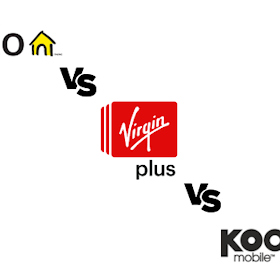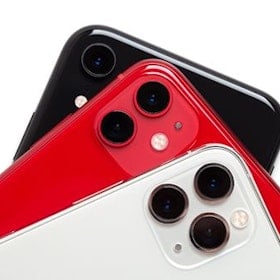
Editor's note: The FiGO Orbit II originally premiered in 2019. It may no longer be available from most carriers or retailers.
Verdict
Although the hardware is very low-end, it's initial price of $79.99 was attractive. Running Android Go Edition 8.1, it can handle almost every app you throw at it. There are a lot of hardware compromises made to get a phone down to this price, but other manufacturers like Alcatel and ZTE have shown that just a few bucks more can vastly improve a low-end device.
What we love
- Cheapest smartphone in Canada
- Lean and modern Google OS
- Google Assistant
- Surprising battery performance
What could be improved
- Slow CPU, small storage, bad audio
- Terrible low-resolution display
- No 5GHz Wi-Fi, no LTE or Bell/Telus
- 2 megapixel camera with poor colour
60/100
What is the FiGO Orbit II?
One of the few Android Go smartphones available in Canada, the Orbit II uses Google's "lite" version of the Android OS to give life to this under-powered yet incredibly cheap cell phone.
FiGO Orbit II Hardware Specs
Although there's a slight bump in hardware specs over the previous FiGO Orbit model, the processor is still just a quad-core MediaTek MT6580 running at 1.30GHz and 1GB of RAM. By comparison, current flagship phones run at 2.5GHz and at least 4GB of RAM. The screen is only 3.9" and 480x800 pixels. The last flagship phone with these specs were the Samsung Galaxy S II. Unlike the Galaxy S II, FiGO's phone runs a "lite" version of Google's OS called Android Go Edition 8.1. This means that most current apps will work on the Orbit II making it the cheapest cell phone in Canada that can run modern Android apps.
There's only 8GB of onboard storage and Android Go only uses 2.3GB. Storage can be expanded using a microSD card up to 32GB in size, although our testing found that larger cards work too.
Cheap Hardware, Cheap Price, Good Performance
With new smartphones costing over $1,000, a cell phone under a hundred dollars will not win any speed competitions. Most Android cell phones under $400 run older versions of Android that don't offer new features that optimize battery, include security updates, or run newer apps. What the Orbit II does give you is a phone that can compete with the best on the market (even if it comes in last).
There's a bit of lag when you start swiping your finger across the screen, but we encountered very few freezes or hangs making us wait for the phone to catch up as long as you don't run too many apps at once.
The screen resolution is only 480x800 which gives you resolution about the same as a DVD. Text can be tricky to read if there's poor contrast (like small grey text on a white screen). The screen is visible in sunlight but viewing angles are terrible. When holding in portrait mode, twisting side-to-side doesn't affect the quality, but tilting forward and back can make the screen unreadable.
While testing the front-facing camera, any attempt to center my face in the screen resulted with darkened contrast or even inverting the image. I could still see the shape of my head, but no details. I had no idea what the other person on the video chat was seeing. Tilting the screen back would let me see the screen better, but then my face was cut off at the bottom of the screen.
Android vs. Android Go Edition
Google's Android OS suffers from fragmentation far worse than Apple's iOS.
Android Go is Google's attempt to get newer features on low-end hardware for cheaper smartphones. While most Android cell phones under $400 don't support the newest Android OS, Android Go Edition is a "lite" version that lets cheap hardware run high-end software.
How They're The Same:
Both Android and Android Go Edition can download apps from the Google Play store. Since Android Go Edition runs a "lite" version of Android 8.1, you can run just about any app that's currently in the Google Play store.
Anyone familiar with an Android phone will feel right at home. While some features have been trimmed out of Go Edition (like Picture-in-Picture video playback), it looks just like any other version of Android. It has the same customizable main screen, widgets, and lock screen with PIN or pattern unlock. Some interface features introduced in Android 8 are here like notification dots, swiping up to open the app drawer, and holding down the home button to activate Google Assistant.
There have been a number of security patches to the Android OS over the last few years and they'll all be in here. Future security updates are probably not coming to Android Go devices.
How They're Different:
Android Go Edition is built to run on low-end hardware. It only takes up half the storage space as the full Android. While it supports Google Play Store apps, a number of "Go Edition" apps are presented so your slow hardware doesn't have to do too much heavy lifting.
Some advanced multimedia features like split-screen apps and Picture-in-Picture (PiP) video don't appear to be a part of Android Go Edition.
What All That Means:
When choosing a new phone, you can pick a modern flagship that costs over $1000, or a more modest device running outdated software. Android Go Edition smartphones let you buy a cheap phone with a current version of Android running on it.
Any new apps on the marketplace will quickly bog down an older Android device, but Android Go Edition phones are built to run lean. You don't get all the bells and whistles but you can still run new apps on incredibly cheap smartphones.

What's good about the FiGO Orbit II?
Cheap:
This is the biggest selling feature. An Android phone for under $80 is hard to pass up.
Google Assistant:
One of the best features added to Android smartphones is the Google Assistant. One long press of the home button from anywhere opens the Assistant. From there you can type or speak to your phone and ask it to check the traffic, set a reminder, call someone in your contacts or just tell you a fun fact (the average pencil holds enough graphite to draw a line 56km long).
Dual-SIM Cards:
It's a very rare thing in Canada to see dual-SIM phones. Dual-SIM phones let you combine multiple plans (and phone numbers) on one device. They're popular in Asia where you can use one plan for data and another for phone calls. In Europe, dual-SIM phones are popular because one plan can be used for local calls and the other plan when roaming in a nearby country. Unfortunately, the FiGO Orbit II is only compatible with the mobile frequencies managed by Rogers Wireless 3G network and used by 7-Eleven Speakout. Using this device on Bell or Telus networks is impossible.
One potential use is if you regularly travel into the US. The Orbit II is compatible with the AT&T 3G network. All phones sold in Canada are unlocked, so you should be able to just pop an AT&T microSIM card in the back of the Orbit II and keep on trucking. Check out AT&T coverage at WhistleOut's American site.
Battery Life:
I came into this review with no expectations of the battery. However I was pleasantly surprised by the battery life in both idle mode and under regular use.
After some preliminary tests after setting up the FiGO Orbit II, I forgot to turn it off when I left it on my desk over the weekend. When I came back on Monday, the battery was less than one-third drained. I let it run for the remainder of the week and found it still had 25% power after six days idling.
Under regular use (talking, photos, playing videos or games) battery life drained at a reasonable speed. Even so, a four-core processor and modest screen specs result in very good power efficiency. I was able to get a full day's use out of the FiGO Orbit II and still have juice left in the battery.
Your experience may vary as more apps and more video playback will drain the battery faster. However, if you only need a cell phone once in a while then you'll appreciate a smartphone that you don't need to charge every night.

What's Not So Good About The FiGO Orbit II?
Hardware Compromises:
You're saving a lot by getting a phone for under $100 Cdn, but you pay for it in other ways. The quad-core CPU handles a few tasks well, but tapping through apps and games too fast will cause performance to crawl. There's 1GB of RAM which is more than most smartphones under $200, but most full-featured apps and games are looking for 2GB or more.
Android Go Edition takes up half the space of the full-powered OS but the 8GB of onboard storage is almost TOO small. Many of the first smartphones on the market ten years ago had 16GB so that should be the minimum here. Additional storage is available through a microSD slot where another 32GB is officially supported.
Audio:
In the box you'll find a USB wall charger, USB-A to microUSB cable, and basic earbud headphones. The included headphones are only slightly better than the Orbit II's tinny built-in speaker. The headphone cable does include a play/pause button and a microphone for voice calls.
Testing with a set of high-quality Bluetooth headphones (not included) and in-car Bluetooth gave me the best hi-fi results. If you're planning to use this to stream music in your car or truck then the Orbit II is a good, cheap option. Android Auto is not supported, but Google Assistant Go will still take your voice commands and apps like Spotify usually include a "Driving Mode".
Mobile Connectivity:
Built-in WiFi lets you connect to older 2.4GHz networks, but 5GHz networks are not supported. This can cause issues in busy locations like apartment buildings. If there isn't a lot of 2.4GHz interference then you should be able to upload and download between 10-30 Mbps.
While on the mobile connection with 7-Eleven SpeakOut, I could connect to a 3G (HSPA+) network but download tests in Toronto and Ottawa were typically between 1.5-2.7 Mbps. Uploads were pretty consistent around 1.0 Mbps. These aren't blazing speeds, but they're fast enough to listen to music online or stream videos.
Low Quality Display:
At 480x800 this is the lowest a modern Android device can go. At that resolution text is blurry and images are not at all sharp. The screen supports adaptive brightness but I found myself manually adjusting it when in bright sunlight. Once maxed out, the screen was more legible but this will drain the battery much more quickly.
When holding the FiGO Orbit II in portrait mode the screen has good viewing angles to the left and right. However, tilting the screen forward and back results in low contrast or even reversed colours. It's not uncommon on cheap displays, but unusual to have this effect when in portrait mode instead of landscape.
This problem is especially noticeable when trying to video chat. Tilting the screen back to get a good viewing angle puts your face too low in the screen, while attempting to center your image results in low-contrast visibility and inverted colours.
Camera:
The rear-facing camera is only 2 megapixel (1600x1200 pixels). By comparison, even low-end smartphones usually have 5 megapixels. The images are grainy and suffer from a lot of compression artifacts. Colours are washed out, have a reddish hue, and images are dark even when shot in bright daylight.
For a low-end camera on a low-end device, the camera's interface impressed me. It puts a lot of control at your fingertips including flash, HDR-mode, and snapshot or video recording buttons.The HDR mode does a fantastic job brightening dark photos, but you have to hold still for about two full seconds to get the shot. Auto White Balance should get rid of that red tinge but rarely does. White balance can be adjusted but with the Orbit II's terrible display you'll never get the right colours on the first try.
The selfie camera is even lower resolution - 640x480 pixels. Images are muddy but there's a built-in front-facing flash.
This camera is good for getting a picture, but you're going to want something better to capture moments you want to remember.
Camera Samples






What else can I buy?

ZTE Z5578
FiGO isn't the only game in town when it comes to Android Go Edition 8.1. ZTE offers a smartphone with larger screen (5.0" 854x480), better camera (5MP rear and 2MP front), and more storage (16 GB). It costs $89 but that's only nine bucks more than the regular price of a FiGO Orbit II after the current promotion ends.

Alcatel 1
One of the first Android Go Edition phones available in Canada, the Alcatel 1 packs similar performance to FiGO's device including only 8GB of storage. The screen is a bit larger and there's a 5MP rear-facing camera but the big advantage is 4G LTE support. It can be bought for as little as $89.99 from Virgin Mobile, Koodo, Bell, Telus, SaskTel and more.

Alcatel GO FLIP
There's more powerful phones, then there's simpler phones. There's nothing like a cell phone that fits in your pocket, and the Alcatel GO FLIP foregoes advanced technology for simple operation. It supports newer 4G LTE networks so you'll have a connection anywhere in Canada there's a signal. It starts as low as $70 but can easily be found for $0 down on a plan.
Find Better Phones and Plans
Hundreds of cell phone plans unpacked. All the facts. No surprises.






































